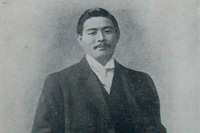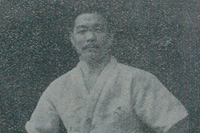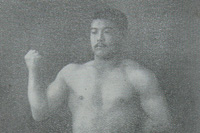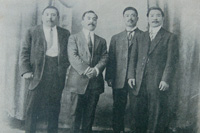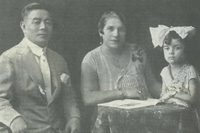Undefeated Conde Koma who challenged the Amazon
"Gracie Jiu-Jitsu" gained much popularity in the Japanese martial arts scene in the second half of the 1990s. Its name left a strong impression thanks to great exploits of Brazilian Rickson Gracie and the Gracie family in mixed martial arts fights which have been carried out under the "vale tudo" (meaning "anything goes" in Portuguese) rule-set. "Jiu Jutsu" is old fashioned sounding and has a fighting style quite different from the modern judo which has become a sport. The fact that Ju-Jutsu, which has its roots in the Kodokan as judo, has evolved along a completely different path in an untapped potential country, or Brazil, has astonished martial arts fans.
It is unknown to anybody other than devout martial arts fans that Ju-Juitsu’s origin lies in a Japanese immigrant named Matsuyo Maeda who was also known by the nickname, Conde Koma (Count Koma). Maeda was more than fundamental to the development of Gracie Jiu-jitsu, and his achievements in life were tremendously great.
Maeda was born as the eldest son of an affluent farming family in Funazawa Village, Tsugaru County, Aomori Prefecture in 1878. It was said he was already able to easily lift two straw rice bags when he was still a young boy, and that he displayed his strength in sumo competions held at a shrine. He quit Aomori Ken Jinjo Chugakko (Aomori Prefecture Standard High School) in 1896 and virtually ran away from home to Tokyo where he enrolled in the just founded Waseda Junior High School. He first encountered judo there and he enrolled in the Kodokan the following year. In 1898, in regular monthly matches in the form of three bouts between unranked students, he defeated senior students one after another who were expected to get a black belt soon, and eventually defeated 10 consecutive opponents. Maeda gradually came to be known within the Kodokan from this time onwards. Maeda enrolled in the Tokyo Senmon Gakko (Tokyo Vocational College, present-day Waseda University), and rose to the rank of 3rd dan in 1901, and began teaching judo at the Gakushuin, the Army Cadet School and other institutions. He distinguished himself even within the Kodokan, and on the analogy of the fact that the four leading disciples directly instructed by Jigoro Kano were called "Kodokan shitenno" (Four Guardians of the Kodokan), Maeda became known as one of the "Kodokan sanba garasu" (Three Pillars of the Kodokan), along with Shota Todoroki and Kaichiro Samura, as the next generation leaders.
In 1907 one of the Kodokan shitenno" (Four Guardians of the Kodokan), Tsunejiro Tomita, was sent to the United States (Annotation1) to help promote judo. Maeda was at his peak physical condition at the time and selected as a companion with Tomita past his physical prime. For Maeda who had always been talking about his dream of leaving Japan for the Eurasian Continent and becoming a bandit or a pirate", this was an offer he could take advantage of to realize his dream.
The two began activities to promote Judo on the east coast of the United States, gave kata demonstrations and held exhibition matches at U.S. Military Academy and Columbia University, and gained new students. In the exhibition matches, although a huge football player and a gym teacher, who, seeing 164cm tall and weighing 68kg, not large Maeda even for an ordinary Japanese of the time, had thought they could easily defeat him, challenged him, he defeated them by his boastful hip strength and nage-waza (throwing techniques) which was achieved by taking advantage of the opponent’s strength. These activities and Japan's victory in the Russo-Japanese War caused a Japan boom and a Ju-Jutsu boom in 1908, and their student recruitment proceeded smoothly. But, although it is unknown whether they were disgusted with being thrown in training or hated repetitive dull exercises, few of these new students remained for a long time. Fake Japanese judo practitioners taking advantage of the boom were challenged and harshly defeated by wrestlers in various regions, and it was also a source of concern for Maeda.
Separating from Tomita, who moved to the west coast to begin the promotion activities there, and remaining on the east coast, Maeda sought to resolve these problems and placed an ad in newspapers to take up a challege of wrestlers in open bouts. Maeda had a plan to publicize its effectiveness in actual combat by demonstrating real judo to American. Although his first open bout was against a wrestler called the Butcher Boy who was a giant 182cm tall and weighing 113kg, Maeda gained a perfect victory by pinfall after tomoenage or circle throw and uranage or rear throw in the first round and with arm lock in the second round. This was the memorable first bout for his mixed martial arts tour around the globe which he was to start with this bout. Rules changed for each match owing to the nature of mixed martial arts ,and in some matches where opponents refused to wear judogi, Maeda had to fight half naked like in a wrestling match. It is said that when he wore judogi in matches, he won all 1,000 matches without a loss.
Afterwards, Maeda continued open matches all over the U.S. to promote judo, but the promotion activities did not have the desired effect, and finally he gave up the promotion in U. S. and left there for the U. K.. The name of judo was already known in the U. K., and eager students enrolled in the judo classes he began in the U. K. unlike in the U.S. Maeda gave lectures and had open bouts in the U. K. as he did in the U.S., and also participated in the wrestling competitions that began to be popular at the time. Meanwhile, he had his first bout against a boxer and won. He used the tactics in this bout: while guarding the head and the pit of stomach, he swiftky rushed towards the opponent in a crouch, grabbed hold of his leg, took him down and locked his arm. In this tactics, you can find a prototype already formed for the tactics of Gracie Jiu-Jitsu under the "vale tudo".
After having bouts in Belgium and France, he went to Spain on an invitation and there his nickname of "Conde Koma" was born. When Maeda visited Barcelona he saw an advertisement for a lecture given by a man calling himself the "Japanese judo champion", who was the man who he had known had not sufficient skill to call themself the champion at all. He decided to offer a challenge to the man under a false name to teach him a lesson so that he should not refuse to accept the challenge if he knew the challenger was Maeda. When he had difficulty hitting upon a good name, he first thought of the name, " Komaru Maeda" from the Japanese word "Komaru" which means "to be in difficultly" as he was in financial difficulty at the time, and at last he decided to take up "Koma" alone from "Komaru" and to add "Conde" which means "count" in Spanish in front of it. Thus his nickname, "Conde Koma" was given birth. He offered a challenge under the name "Conde Koma", but his opponent soon found the challenger was Maeda and called off the bout. It was said that the man who had learned his lesson stopped calling himself the judo champion. (Sekai oko judo musha shugyo)
Next Maeda left Europe and headed to Central and South America. Martial arts entertainments were also very popular in Cuba and Mexico. When the spectators saw small Maeda easily defeat huge wrestlers, they got excited and the enterainments became extremely popular. Thereafter, he went south from Guatemala to Panama in Central America, then entered South America and visited Peru, Bolivia, Chile, Argentina and Uruguay along the Pacific coast, and set foot on Brazil for the first time when he arrived at the port of Santos in 1914. After teaching judo at the naval academy for a time, the next year he went north and arrived in the city of Belem, a place for him to live permanently, at the mouth of the Amazon River,. Since Maeda experienced a Japanese exclusion mood at first hand during his activities in the U.S., he automatically came to look for the second place for Japanese people to develop during the tour in Central and South America. Then he convinced himself that this place was the place he had looked for because he found the bountiful nature of the Amazon, the beautiful European-like streets in Belem, and easy-going lifestyle of the local people there. The second act of Maeda's life began from here.
When Maeda arrived, Belem was in the midst of its 300 year anniversary festival, and as one of the festival’s events a luta livre wrestling tournament was held which was advertised as deciding who was the strongest man in the Amazon. Maeda participated the tournament with no entry and won. The exploits of the "Conde Koma" in various areas of Central and South America were already well known in the Amazon, but when people in Belem saw his strength and respectable attitude with their own eyes, they welcomed him respectfully. While teaching judo to the police and the military, he also recruited private judo students, and many influential figures in the region and their children signed up as a student. Afterwards, a Scottish entrepreneur, Gastao Gracie also asked Maeda to teach his son Carlos (Annotation2) at his cheekiest judo. In addition, taking advantage of the knowledge he acquired from the "seitai" practice, he was engaged in home visit massage. This gave him the opportunity to fit in with members of the upper class in Belem, and he was called "Professor Conde Koma" and became an influential man among Japanese immigrants.
Meanwhile, he made an expedition to Cuba and Mexico, and held open bouts in Belem from time to time. When he became more than 40 years old in 1922, he determined to retire from activity as a martial artist, and get earnestly involved in the projects for constructing settlements in the Amazon. In 1924, he married with Daisy May Iris, an English nurse, who kindly attended to him while he hospitalized for kidney disease, and they later adopted a daughter, Celeste.
The Japanese Government re-examined its emigration policy which had placed great importance on the State of São Paulo, and began to inspect the Amazon as a promising area for settlement, as if in concert with Maeda’s determination. In addition, the State of Para also had a plan to entrust the development of as yet untouched Amazon regions to Japanese people. When a nonregular staff of the Ministry of Foreign Affairs, the Ambassador to Brazil and the survey team of Kanebo visited the Amazon for the inspection, Maeda, who had already had wide acquaintance with leading figures in the State Government, positively volunteered as a guide and enthusiastically explained the potential of the Amazon.
Afterwards, Maeda himself also became a nonregular staff of the Ministry of Foreign Affairs, and when the Nanbei Takushoku Kabushiki Kaisha (South America Colonization Limited Company) was established to carry out the government policy for settlement in the Amazon, he was assigned an auditor of its local agent company. In addition, when the Amazonia Industrial Company was established by Tsukasa Uetsuka , Maeda was assigned a director. He tirelessly carried out negotiations with the State Government and took care of settlers.
Contrary to Maeda’s expectations, however, projects for Japanese immigrants settlement with the aim of agricultural land reclamation in the Amazon basin were going hard. Maeda received settlers in Belem, and saw them off and gave them a lot of encouragement, saying "don't come back!", but soon not a few of them came back one after another with their dreams broken. At a time like this, Maeda would pretend to be angry with them with a sad expression on his face, but then he would take them to his home, serve them a meal, and help them find work in Belem.
For nearly 20 years after entirely settling in Belem, Maeda had devoted himself to the Amazon settlement project, with the passage of time, however, his chronic kidney disease deteriorated, and in November 1941, without ever seeing the development of the Amazon fulfilled, he died at age of 63. At his funeral, cars formed a line from the downtown in Belem to his grave to see off his casket. Since travelling to the U.S. with Tomita, Maeda had never set foot on his native soil again. After he became almost a private ambassador in Belem, he was encouraged to return to Japan by the Japanese Government as well. Although feeling homesick for Japan, he refused to follow all the suggestions. No one can tell if the reason was that settlement projects in the Amazon he believed in was far from complete, or that he respeceted the feelings of his family living in Brazil, or not.
Maeda wrote in a private letter in 1930 :
"Since settlement will not bear fruit in a couple of years as a matter of course, I believe that when my body rots away and white bones alone remains in the grave, a day will come when a prosperous fellow immigrant with information that the grave marker of a Japanese, Maeda Conde Koma is located near here will find the small moss-covered grave marker. On that day, how greatly my immoral soul will be pleased to know my belief has been realized."
In Tome-Acu black pepper was successfully cultivated with the use of the seedling a Japanese brought and unprecedented economic success was brought to the Amazon more than 5 years after Maeda passed away.
| Annotation1 | Before then, Yamashita Yoshiaki, one of the "Kodokan shitenno" (Four Greatest Guardians of the Kodokan), had travelled to the U.S. and instructed the U.S. President Theodore Roosevelt in Judo. |
|---|---|
| Annotation2 | After learning from Maeda for approximately 4 years, he then moved back to Rio de Janeiro in 1925 and established the Rio de Janeiro Academy with his brother Helio and other family there. |

